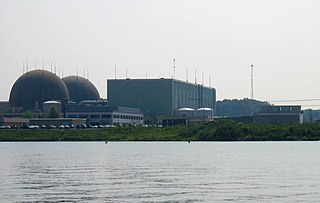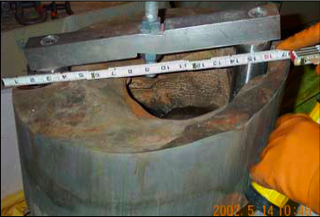
The Nuclear Regulatory Commission (NRC) is an independent agency of the United States government tasked with protecting public health and safety related to nuclear energy. Established by the Energy Reorganization Act of 1974, the NRC began operations on January 19, 1975, as one of two successor agencies to the United States Atomic Energy Commission. Its functions include overseeing reactor safety and security, administering reactor licensing and renewal, licensing radioactive materials, radionuclide safety, and managing the storage, security, recycling, and disposal of spent fuel.

The Shearon Harris Nuclear Power Plant is a nuclear power plant with a single Westinghouse designed pressurized-water nuclear reactor operated by Duke Energy. It was named in honor of W. Shearon Harris, former president of Carolina Power & Light. Located in New Hill, North Carolina, in the United States, about 20 miles (30 km) southwest of Raleigh, it generates 900 MWe, has a 523-foot (160 m) natural draft cooling tower, and uses Harris Lake for cooling. The reactor achieved criticality in January 1987 and began providing power commercially on May 2 of that year.

The Diablo Canyon Power Plant is an electricity-generating nuclear power plant near Avila Beach in San Luis Obispo County, California. Since the permanent shutdown of the San Onofre Nuclear Generating Station in 2013, Diablo Canyon is the only operational nuclear plant left in the state, and the largest single power station in the state. The facility was the subject of controversy and protests, both during its construction and operations, including nearly two thousand civil disobedience arrests in a two-week period in 1981.

Oyster Creek Nuclear Power Station was a single unit 636 MWe boiling water reactor power plant in the United States. The plant is located on an 800-acre (3.2 km2) site adjacent to Oyster Creek in the Forked River section of Lacey Township in Ocean County, New Jersey. At the time of its closure, the facility was owned by Exelon Corporation and, along with unit 1 at Nine Mile Point Nuclear Generating Station, was the oldest operating commercial nuclear power plant in the United States. The plant first started commercial operation on December 23, 1969, and is licensed to operate until April 9, 2029, but Oyster Creek was permanently shut down in September 2018. The plant got its cooling water from Barnegat Bay, a brackish estuary that empties into the Atlantic Ocean through the Barnegat Inlet.

The H. B. Robinson Steam Electric Plant, also known as Robinson Nuclear Plant, is a nuclear power plant located near Hartsville, South Carolina. The plant consists of one Westinghouse 759 MW pressurized water reactor. The site once included a coal-fired unit that generated 174 MW and a combustion turbine unit that generated 15 MW.

The Byron Nuclear Generating Station is a nuclear power plant located in Ogle County, Illinois, 2 miles (3.2 km) east of the Rock River. The reactor buildings were constructed by Commonwealth Edison and house two Westinghouse Four-Loop pressurized water reactors, Unit 1 and Unit 2, which first began operation in September 1985 and August 1987 respectively. The plant is currently owned and operated by Commonwealth Edison's parent company, Exelon Corporation.

The North Anna Nuclear Generating Station is a nuclear power plant on a 1,075-acre (435 ha) site in Louisa County, Virginia, in the Mid-Atlantic United States. The site is operated by Dominion Generation company and is jointly owned by the Dominion Virginia Power corporation (88.4%) and by the Old Dominion Electric Cooperative (11.6%).

The Prairie Island Nuclear Generating Plant is an electricity-generating facility located in Red Wing, Minnesota along the Mississippi River, and adjacent to the Prairie Island Indian Community reservation.

Columbia Generating Station is a nuclear commercial energy facility located 10 miles (16 km) north of Richland, Washington. It is owned and operated by Energy Northwest, a Washington state, not-for-profit joint operating agency. Licensed by the Nuclear Regulatory Commission in 1983, Columbia first produced electricity in May 1984, and entered commercial operation in December 1984.

Point Beach Nuclear Plant is a nuclear power plant located on Lake Michigan in the town of Two Creeks, Wisconsin, United States.

Nuclear power in the United States is provided by 94 commercial reactors with a net capacity of 96.6 gigawatts (GW), with 63 pressurized water reactors and 31 boiling water reactors. In 2019, they produced a total of 809.41 terawatt-hours of electricity, which accounted for 20% of the nation's total electric energy generation. In 2018, nuclear comprised nearly 50 percent of U.S. emission-free energy generation.
Nuclear history of the United States describes the history of nuclear affairs in the United States whether civilian or military.

Nuclear safety in the United States is governed by federal regulations issued by the Nuclear Regulatory Commission (NRC). The NRC regulates all nuclear plants and materials in the United States except for nuclear plants and materials controlled by the U.S. government, as well those powering naval vessels.

Harold Ray Denton was the Director of the Office of Nuclear Reactor Regulation at the United States Nuclear Regulatory Commission (USNRC) and is best known for his role as President Jimmy Carter's personal adviser for the Three Mile Island (TMI) accident.
The 1970s proved to be a pivotal period for the anti-nuclear movement in California. Opposition to nuclear power in California coincided with the growth of the country's environmental movement. Opposition to nuclear power increased when President Richard Nixon called for the construction of 1000 nuclear plants by the year 2000.

The United States Government Accountability Office reported more than 150 incidents from 2001 to 2006 of nuclear plants not performing within acceptable safety guidelines. According to a 2010 survey of energy accidents, there have been at least 56 accidents at nuclear reactors in the United States. The most serious of these was the Three Mile Island accident in 1979. Davis-Besse Nuclear Power Plant has been the source of two of the top five most dangerous nuclear incidents in the United States since 1979. Relatively few accidents have involved fatalities.

GE Hitachi Nuclear Energy (GEH) is a provider of advanced reactors and nuclear services. It is headquartered in Wilmington, North Carolina, United States. Established in June 2007, GEH is a nuclear alliance created by General Electric and Hitachi. In Japan, the alliance is Hitachi-GE Nuclear Energy. In November 2015, Jay Wileman was appointed CEO.

The nuclear energy policy of the United States developed within two main periods, from 1954–1992 and 2005–2010. The first period saw the ongoing building of nuclear power plants, the enactment of numerous pieces of legislation such as the Energy Reorganization Act of 1974, and the implementation of countless policies which have guided the Nuclear Regulatory Commission and the Department of Energy in the regulation and growth of nuclear energy companies. This includes, but is not limited to, regulations of nuclear facilities, waste storage, decommissioning of weapons-grade materials, uranium mining, and funding for nuclear companies, along with an increase in power plant building. Both legislation and bureaucratic regulations of nuclear energy in the United States have been shaped by scientific research, private industries' wishes, and public opinion, which has shifted over time and as a result of different nuclear disasters.
Diablo Canyon (Nuclear) Power Plant, located in San Luis Obispo County California, was originally designed to withstand a 6.75 magnitude earthquake from four faults, including the nearby San Andreas and Hosgri faults, but was later upgraded to withstand a 7.5 magnitude quake. It has redundant seismic monitoring and a safety system designed to shut it down promptly in the event of significant ground motion.
The Atomic Safety and Licensing Board Panel (ASLBP) is an independent adjudicatory division of the United States Nuclear Regulatory Commission, authorized under the Atomic Energy Act. The ASLBP consists of administrative judges that differ from other administrative law judges in other Federal agencies, most notably that Licensing Boards have technical judges who are experts in their relative field of study. Licensing Boards hear claims by petitioners who seek to intervene in a licensing action before the NRC. The ASLBP's jurisdiction is limited to the scope of the licensing action before the NRC, commonly outlined in the Federal Register when a licensing action is published to give notice of the pending action and calls for petitions. Licensing Boards commonly hear matters arising under the Atomic Energy Act, the National Environmental Policy Act, the National Historic Preservation Act of 1966, and the NRC's regulations in Title 10, Code of Federal Regulations. Licensing Boards hear licensing matters concerning the licensing matters of nuclear power plants, in situ leach uranium mining, spent fuel storage facilities, and enforcement matters of individuals who hold an NRC-issued license.















